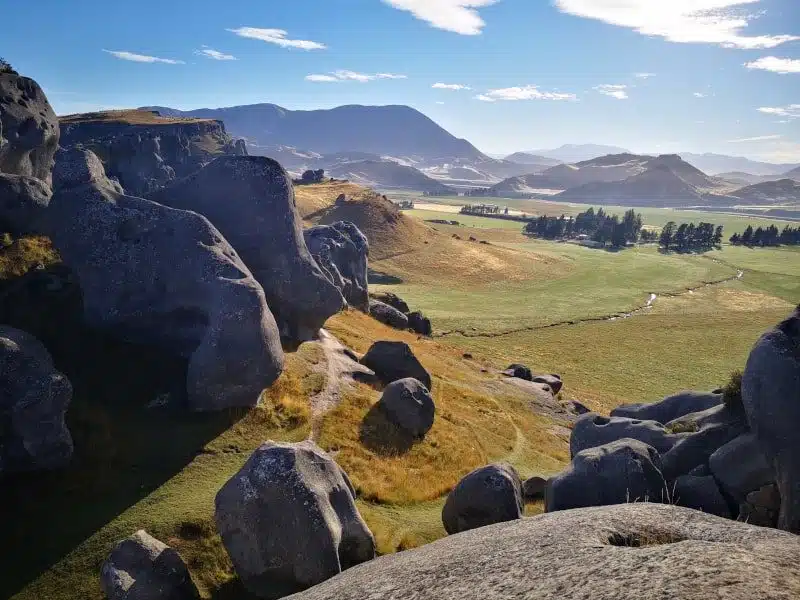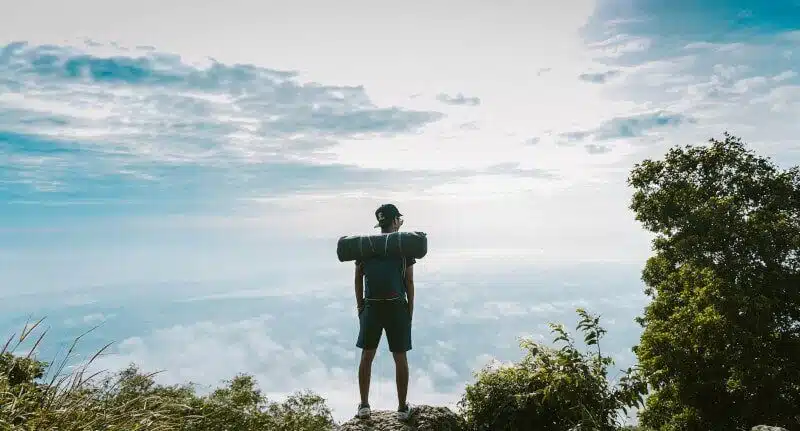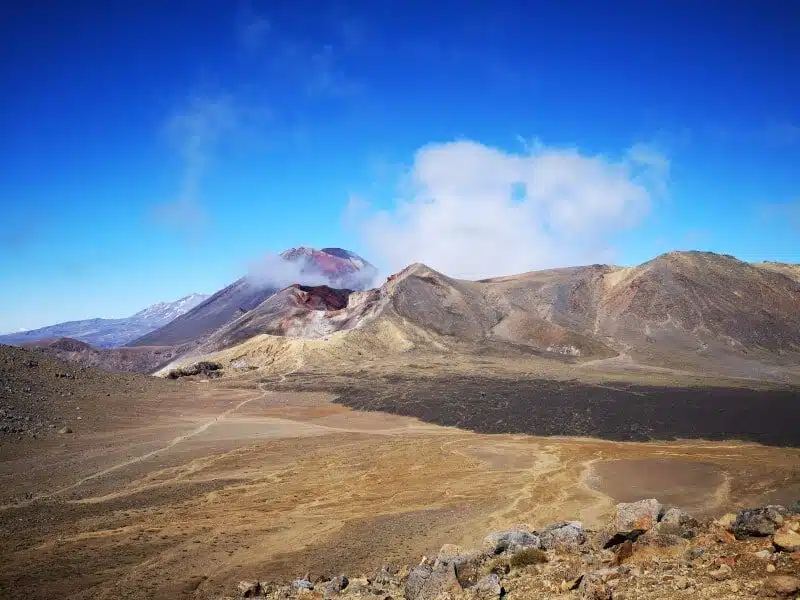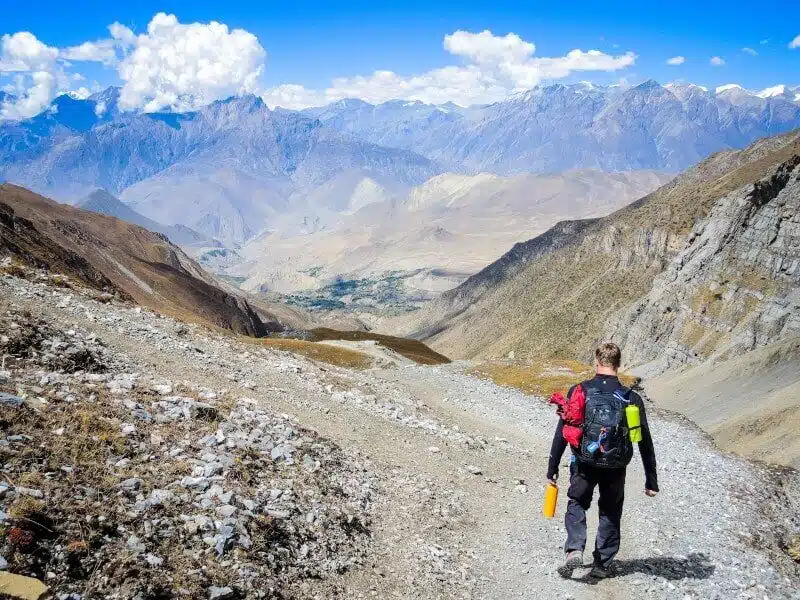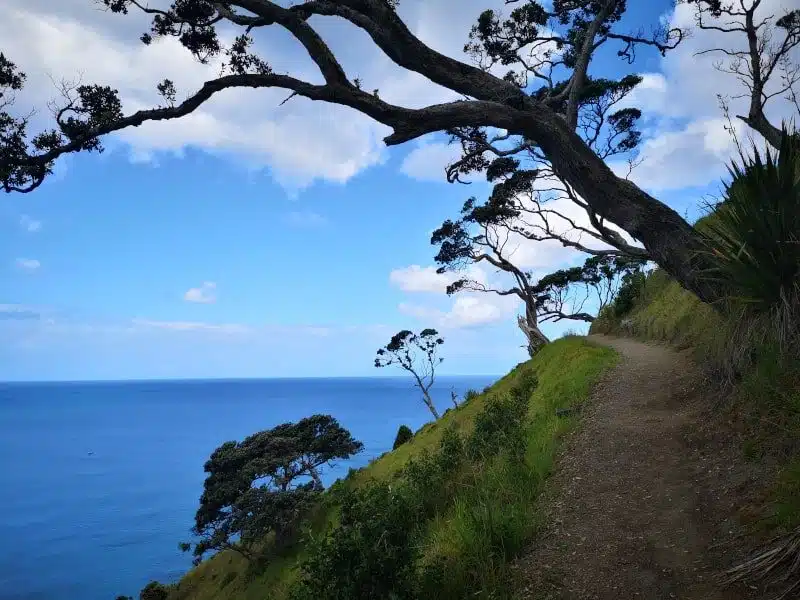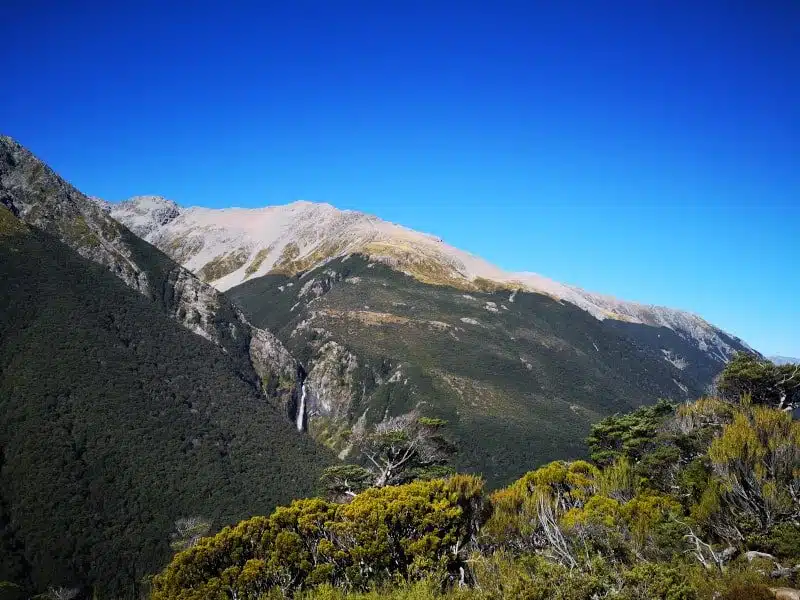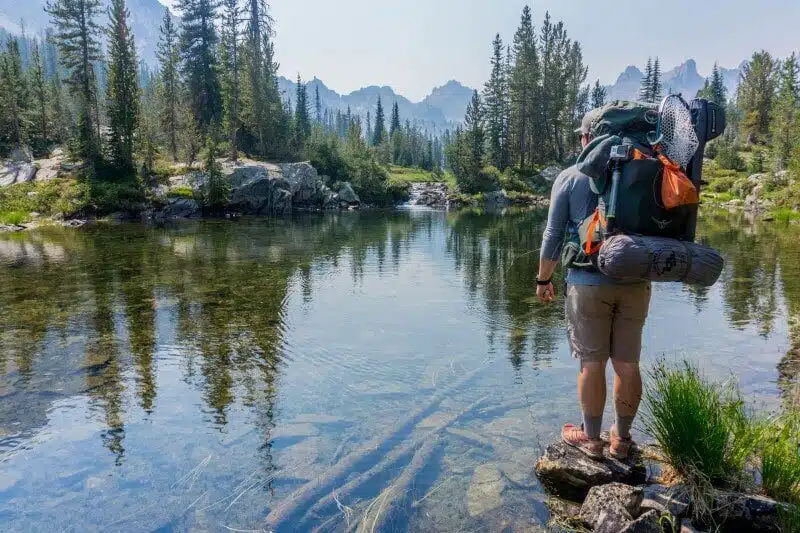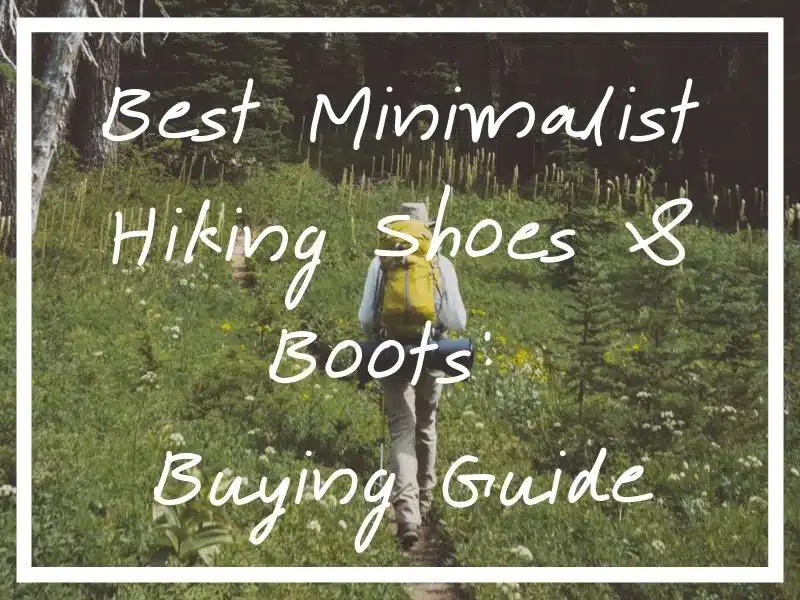
I hope this guide helps you find the best minimalist hiking shoes or boots possible!
My trusty hiking shoes have finally had it.
After more than 3 years of constant use, I’ve glued the soles back on more times than I can count, the waterproofing’s caput, and the laces are torn to shreds.
They’ve seen me through rain, shine, mud, snow, and everything in between. But it’s time to face facts:
I need some new ones!
I’ve been on the hunt for sturdy, lightweight, and stylish footwear for a while.
And, from what I can see, minimalist hiking shoes or boots seem ideal.
However, there’s a huge selection of minimalist/barefoot hiking shoes and boots to choose from online, making it hard to separate the best minimalist hiking shoes and boots from the worst.
I figured I’d do some research into the best minimalist trekking shoes and boots out there, and then write it all up in this post!
Are you looking for some new minimal hiking shoes too? Well, I hope this will help. Read on to discover all about 10 of the best minimalist hiking boots and shoes I could find.
[Last Updated: January 2021]
Best Minimalist Hiking Shoes & Boots – Summary Table
Style: All-Rounder
Weight: <2lbs (0.9kgs)
Rating: 4.5/5
Price:
Style: Barefoot Trail
Weight: Unspecified
Rating: 4.4/5
Price:
Style: Zero-Drop Boot
Weight: 1lb (0.45kgs)
Rating: 4.5/5
Price:
Style: Five-Finger
Weight: <1lb (0.45kgs)
Rating: 4.6/5
Price:
Style: Water shoe
Weight: 0.75lbs (0.34kgs)
Rating: 4.5/5
Price
Style: Traditional Boot
Weight: 0.75lb (0.34kg)
Rating: 4.5/5
Price:
Style: Traditional Hiking
Weight: <2lb (0.9kgs)
Rating: 4.6/5
Price:
Style: Standard Trail
Weight: 0.68lbs (0.3kgs)
Rating: 4.6/5
Price:
Style: Barefoot Outdoor
Weight: 0.77lbs (0.35kgs)
Rating: 4.4/5
Price:
Style: All-Rounder
Weight: 0.62lb (0.28kg)
Rating: 4.3/5
Price:
Wondering what a minimalist hiking shoe actually is? Me too. It wasn’t particularly well-defined online, yet some common features did stand out…
What Are Minimalist Hiking Shoes & Minimalist Hiking Boots?
First thing’s first, though: what actually is a minimalist hiking shoe/boot?
I couldn’t find a clear definition. Overall, though, minimalist boots seem to be synonymous with barefoot hiking shoes and boots. In other words, they have the following qualities as standard:
- Lightweight
- Slight padding
- Level of ‘feel’ with the ground
- Protective without going overboard
- Commonly zero-drop (meaning flat soles)
- Oh, and, like all minimalist gear, they look bloody cool too.
And beyond all that, minimalist gear always seems to be a great blend of aesthetics and functionality. It’s no thrills gear that gets the job done, while looking sleek and stylish in the process.
Related content you might find useful:
Why Buy Minimal Hiking Shoes or Minimal Hiking Boots?
Top Benefits of Minimalist Walking Boots
Okay, with that (very vague) definition out of the way, let’s trundle onwards!
Next up, what benefits do minimalist hiking boots and shoes have over others? The definition above may have offered some clues. But I think it’s worth delving a bit deeper anyway.
Here’s why buying them makes sense:
1. They’re Lightweight Hiking Shoes
This seems one of the primary perks provided by minimalist footwear:
They’re far lighter than other options.
And they’re awesome for it.
I hate walking with enormous, heavy shoes on my feet. They always feel ungainly and sap your energy over longer hikes.
Likewise, for any travellers reading this, hitting the road with heavy boots is horrible! That extra weight makes all the difference when you’re lugging a 15-20kg backpack around (here are some further tips for travelling you might find useful).
Of course, the weight reduction comes at a slight cost. They sacrifice a bit of the protection you get with bulkier boots.
All told, though, I’d say it’d be worth it for the added convenience and ease.
2. They’re Simple Yet Functional Waterproof Hiking Shoes
Minimalist boots aren’t pretentious in any way.
There’s something humble about them, which I like a lot. It’s no frills, bells or whistles stuff.
Their simplicity is endearing! Even better, they get the job done. They’re entirely functional.
If minimalist boots were people, they’d be the star employee who nails their sales targets every month without raving to everyone about it.
Bad analogies aside, these boots seem like the perfect balance between functionality and simplicity.
3. They Look Great
Oh, and they look awesome too.
That’s another thing I love about minimalist gear:
It’s inevitably got a fair dose of aesthetic appeal to its name as well. The same goes for the hiking footwear. Simply, they look really bloody cool.
Looking for more minimalist gear? Here are the best minimalist backpacks I could find too.
The best barefoot hiking shoes are versatile enough to suit most hiking conditions.
4. They’re Versatile Hiker Shoes
Here’s another benefit of minimalist trekking shoes and boots: they’re versatile.
Thanks to their lightweight and stylish nature, you can wear them off the trail as well as on it and still look pretty cool.
5. They’re a (Relatively) Inexpensive Hiking Shoe
Price is usually a big factor in boot-buying decisions. Typical hiking boots aren’t cheap! You can spend hundreds of dollars on a brand new pair of branded boots.
Nicely, minimalist varieties are often relatively inexpensive. Now, this isn’t always the case! Compared to high-end alternatives, though, your money often goes a bit further.
6. They Feel Different when Hiking Barefoot
Another reason minimalist footwear is becoming so popular is the way they feel.
Obviously, they weigh less and have less padding. That amounts to greater sensitivity to the ground underfoot. So long as you get enough support, that’s no bad thing.
Anyone who wants to feel the ground beneath their feet is sure to find this appealing.
7. They’re Better For your Feet
Minimalist footwear’s said to be good for your hooves as well.
I’m not entirely sure why, but it’s something to do with the relative lack of cushioning and support (versus alternative types of footwear).
Essentially, the muscles in your feet and lower legs have to work harder. Over time, that extra usage strengthens them up and prevents foot injuries.
There are caveats though. Using super-lightweight footwear (especially for heavier-set individuals) can actually raise the risk of injury. Here’s a little more info on this if you want to read up on it.
Rocky, mountainous terrain demands quality hiking shoes or boots. The following considerations should help you find the best pair possible.
How to Choose the Best Minimalist Hiking Boots & Shoes
With the basics covered, let’s turn to how to choose the best minimalist hiking footwear. Here are the top considerations for choosing your new boots:
1. How the Waterproof Minimalist Shoes Fit
The fit is always a priority, whenever you buy new footwear.
At the most basic level, new shoes and boots must fit your feet.
You’re obviously not going to buy them if you can’t get your feet inside, or if you can shake them loose! However, it gets a bit more technical than that with hiking boots.
Fit is the most important part of the decision-making process.
Everyone’s feet are different. The boots you buy should be a snug fit all over your foot. Emphasis on the word ‘snug’. That definitely doesn’t mean tight. Tight is bad!
Unfortunately, it can be hard to tell the difference sometimes (the tips coming up should help).
As a rough guide, your new boots should hug your foot; you should be able to wiggle your toes, but there shouldn’t be excessive room above them inside the boot. Your feet shouldn’t slip around, or scrunch up (even when facing ‘downhill’).
2. Comfort-Levels of Minimalist Hiking Shoes
Again, nobody wants to buy a pair of boots that feels awful on their feet. But comfort-levels often remain a mystery until you try them out on the trail.
The best you can usually do is to buy a pair that feels as comfy as possible from the outset. This gives you a better chance of enjoying them when you eventually put them to work.
3. Support-Levels of Waterproof Hiking Shoes
Most high-quality hiking shoes and boots do a good job of supporting your feet and ankles.
Different ‘cuts’ provide varying degrees of support though. Essentially, the ankle support extends to varying heights up your ankle and leg! The higher it goes, the more support you get.
However, they’ll also be heavier, and probably more expensive too. This is where it pays to reflect on where you’ll be using your boots.
For gentler hikes over reasonable terrain, a lower cut should be fine. For rougher terrain and longer hiking, though, more support’s always preferable.
Likewise, think about the weight you’ll be carrying on your back.
Long hikes usually require heavier backpacks full of gear and food. Having sturdier minimalist shoes or boots with high-cut ankle support might be the best bet.
4. The Materials of Barefoot Trekking Shoes
Materials obviously come into play as well.
Go to the outdoor shop and you’ll see a range of boot materials displayed.
The aesthetics and feel of the materials is one thing to think about. But, in reality, the most important factor’s arguably the level of waterproofing.
It’s vital to pick boots and shoes with top levels of waterproofing. Gore-Tex boots are the gold standard to look for. See the Gore-Tex label and you know your tootsies will stay nice and dry!
Another material-related consideration is the maintenance requirements.
For instance, leather boots require a bit more maintenance to sustain their quality. For example, failing to clean and dry them can lead to cracks and reduced waterproofing.
The soles of your minimalist hiking boots and shoes are key for covering ground safely.
The Minimalist Hiking Boots Shoes Soles
Pay attention to the soles of the minimalist boots and shoes as well.
After all, this is what’s providing protection between you and the ground. It’s worth investing in some boots with reasonable outsoles to keep your tootsies happy.
On hiking footwear, you’ll often find rubber soles as standard. However, two points of interest are what’s known as the ‘lug pattern’ and the ‘heel brake’.
The lugs are the bumps and grooves that provide grip on the trail. Ideally, you want soles with deeper and thicker lugs to provide traction over rough ground. No-one wants to fall over in the mud! Good lugs help stop that happening.
The heel brake is, as you probably guessed, the part of the sole under your heel! It should be designed in a way to stop your sliding when going downhill.
Hiking in minimalist shoes and boots/barefoot trekking shoes is a little different.
As you’ll see, barefoot designs try and replicate the experience of walking directly on the ground.
That means the soles are thinner, and ‘zero drop’; there’s no height difference between front and back. It’s meant to feel great, put you ‘in touch with the land’, and strengthen your feet.
The Stiffness of Your Minimal Hiking Boot
A stiff boot might sound like a bad thing.
However, it depends entirely on your needs.
Walking long distances over tough terrain can make a stiff boot a better option.
Flexible boots that bend easily tend to offer less support. You’ll feel the rocks and bumps underfoot far more.
In reality, minimalist boots are likely to have lower stiffness than other options. Many people love the fact they can feel the ground underfoot.
Stiffness is worth thinking about if you’re planning on serious hiking in extreme landscapes though.
The Price of the Best Minimalist Hiking Boots
There’s no point splurging on a pair of minimalist hiking boots that are out of budget. Stick within your price range.
That said, it’s worth seeing your hiking footwear as an investment! Sure, you could buy some for under 50 bucks, but the standard’s never going to be as good as a $300 pair.
Paying more upfront can save you money long term. They’ll last longer thanks to their durable materials and premium build-quality.
As it happens, most options in the coming list are incredibly inexpensive. It seems like another benefit of buying minimalist shoes and boots online! Everything seems crazily cheap compared to what I’ve paid in-store in the past for ordinary walking boots.
The following advice should help you find the perfect minimalist hiking footwear.
Top Tips for Finding the Perfect Minimalist Hiking Footwear
The actual minimalist hiking boot reviews are coming up, I promise!
First, though, I thought it might help to highlight some tips for the buying process. The following set of advice should help guarantee you walk away (in your new boots) happy as Larry.
(FYI, most of these tips only apply when you’re buying them in-store, and not online.)
1. Consult with the Shop Assistant
Okay, tip number 1: speak with the retail assistant on the shop floor.
I always find genuine value in asking the guys and girls in outdoor stores for help- especially when I’m buying footwear.
They can listen to your needs and make recommendations accordingly. They’ll then help you find the perfect style and fit. Of course, they can provide answers to any questions you have in the process too.
Equally, I tend to find these guys have a genuine passion for the outdoors.
They aren’t just there to look pretty and sell stuff! They love the outdoors, value great gear, and can make knowledgeable recommendations based on real-world experience.
Be sure to leverage that insight when you’re in-store and on the hunt for shoes/boots.
2. Try With the Right Socks
This is hiking shoes/boot buying 101:
Make sure you wear a pair of actual hiking socks to the shop- or take some with you. It’ll give you a much more accurate idea of what a boot will feel like in use.
Remember, walking socks are thicker than ordinary ones and some even have multiple layers that literally double their thickness!
The last thing you want is to wear ordinary socks to the store, buy a pair that fits, and then realize they’re too small when you’re wearing proper hiking socks!
Buying online? Be sure to take this into account. It might be worth buying a boot half a size larger than usual. Make sure you can send the boots back if they don’t fit properly.
3. Try At the End of the Day
Doesn’t it feel incredible to take off your shoes at the end of a long day?
Know why?
It’s because your feet tend to swell throughout it. Come the evening, your feet are literally bigger than they were that morning. Removing your shoes literally takes the pressure off.
Keep this in mind when shoe and boot buying.
Going at the end of the day better reflects the state of your feet on the trail. Walking long distances will also lead your feet to get warmer and swell up.
You want to buy boots that you know won’t be too uncomfortable when that happens.
4. Remember Your Orthotics
Do you wear orthotics (the specially made shoe inserts that help you walk better)?
If so, be sure to take them to the store when you’re buying your minimalist hiking boots. Same goes for insoles. If you’re used to wearing insoles in your shoes, then take some along.
5. Walk Around the Store
Classic mum advice here, but be sure to walk around the store when you’re trying footwear on.
You want to see if they fit properly, if they rub your ankles or toes, and how they feel in general. Walking around the store gives you a general idea of each of these things.
Test them out! Walk on tips toes to simulate downhill sections on trails. Step up onto seats to simulate rocky, stepped sections, and so on. Jump, squat, wiggle, and jiggle your way around the store to see how they feel.
6. Opt for Familiar brands (Especially When Shopping Online)
Have you, like me, had the same pair of hiking shoes for ages? If so, then use it to your advantage in your shopping. Let me explain…
At the end of the day, buying shoes and clothes online is a little risky. Everybody does it, and, nicely, you can almost always return the items.
But buying boots without first trying them on obviously leaves some room for error.
You can mitigate the risk by finding a similar (or the same) pair as before, from the same brand.
Alternatively, just stick with the brand. You already have first-hand experience of their quality and know they make great boots that you enjoy wearing.
Going hiking in the great outdoors? You need some quality footwear. Hopefully, the coming reviews will highlight the best minimalist hiking boot or shoe for your needs.
The Best Minimalist Hiking Boot Buying Guide: Top 10 Minimalist Hiking Shoes and Boots Reviews
Okay, finally, on to the minimalist hiking boot reviews themselves! I hope you find a pair you like!
1. Vasque Men’s Juxt Multisport
Key Features
- Material: Suede leather
- Sole: Vasque OTG (Off the Grid)
- Rubber outsole for additional comfort
- Weight: <2lbs (0.9kgs)
Description
I really like the look of these Vasque hiking shoes.
They tick a lot of boxes: solid rubber soles, pretty lightweight and (relatively) budget-friendly. They’re also smart aesthetically.
I’d say you could easily get away with wearing these out and about more generally.
Functionality is obviously important, though. The Vasques seem to have you covered here too.
There’s some serious lug on the sole. That means good grip over slippery surfaces, which is always essential.
The ankle cut is fairly low. However, compared to other minimalist shoes on this list, it doesn’t seem too bad. It looks to offer a good level of ankle support.
Slight downsides include the potential waterproofing issues. They’re said to be best for dry terrain.
Overall, this seems like a well-made, good-value, smart-looking hiking shoe.
Pros
- Budget friendly
- Lightweight
- Breathable
- Value for money
- Great for dryer climates
- Easy to break-in
Cons
- No waterproof barrier
- Potential durability issues
2. Vibram V-Trek Toe Shoes
Key Features
- Toe shoe (‘five fingers’)
- Vibram Sole
- ‘Megagrip’ rubber outsole
- Weight: <1lb (0.45kgs)
Description
I’ve always been interested in ‘five fingers’ shoes.
They look a little strange, but super comfortable too. These Vibram V-Trek shoes are no exception!
Indeed, comfort was a common positive quality described in online reviews. Even better, these Vibrams seem functional too.
Vibram soles have a stellar reputation. These ones will protect your feet, while maintaining a sense of ‘feel’ between you and the ground. You’ll enjoy the high level of grip they offer too.
This is barefoot, minimalist hiking at its best.
Your feet’ll get wet. But the shoes are rapid drying, which is good news. There’s nothing worse than having constantly soggy feet on long hikes. Expect high flexibility too, and good versatility for all terrain.
In terms of cons, I read a couple of reviews about potential bad smells and rubbing.
Both issues seem a natural outcome of barefoot walking to me, though.
All things considered, if you like the alternative aesthetic style, then I think you’ll love these minimalist shoes for hiking.
Pros
- Lightweight
- Comfort
- Versatile for all terrains
- Good grip
- Quick drying
Cons
- Possible durability issues with intense use
- Potential bad smells
- Occasional rubbing
3. Merrell Men’s Moab 2 Vent
Key Features
- Material: suede leather and mesh
- Vibram sole
- Protective rubber toe cap
- Cushioned mesh tongue
- 5mm lug depth
- Weight: <2lb (0.9kgs)
Description
I wanted to include a pair of more traditional hiking shoes.
It’s up for debate if these still count as ‘minimalist’! If I’m honest, I don’t think they do! However, they do provide a nice point of comparison to other items on this list.
These are far from zero-drop, barefoot walking. You’re looking at bulky shoes with heavy tread, significant lugs, and thick soles! There’s much more ankle support and better waterproofing.
Nicely, these Merrell’s are still lightweight in nature though.
Even better, Merrell is a well-respected brand in the hiking industry. That usually amounts to quality.
I’d say they’re an absolute bargain at the price they’re being sold at too.
One point I came across was its high flexibility. It’s suggested that they’re less suited to long distance and heavyweight hikes.
However, expect them to perform better in this regard than other, more typical, minimalist shoes on this list.
Pros
- Super comfortable
- Supportive
- Good underfoot protection
- Lightweight
- Good traction
- Good waterproofing
- Value for money
Cons
- Relatively high flexibility (though no worse than others on this list)
- Minimalism debatable
4. Whitin Cross-Trainer Best Barefoot Hiker Shoe
Key Features
- Zero drop hiking shoe (flat sole)
- Removable in-sole
- Wide toe space
- Weight: 0.77lbs (0.35kgs)
- Material: ?
Description
These Whitins may be more like what you had in mind for a minimalist shoe.
They’re super-lightweight, zero-drop, and designed as barefoot footwear.
Ergonomic considerations have gone into the design.
They include a widened toe space to enable your feet to spread out on the move. That’s meant to be better for the foot, versus constrictive alternatives.
For me, this is a no-nonsense bit of minimalist hiking footwear. It’s no-frills stuff, which is arguably how it should be.
There’s some decent tread on the sole (though don’t expect the same level of grip as other shoes), they’re easy to clean, and comfortable to wear. They’re better-suited to shorter hikes with lighter loads.
Animal-welfare inclined? You’ll like the Whitins. They’re made with vegan-friendly materials. No animals were harmed here.
Top tip: According to recommendations, if you need a half size, then opt for the next size down when ordering the shoe.
Pros
- Super cheap
- Vegan friendly materials
- Barefoot design
- Wide selection of colours/styles
- Inexpensive
- Durable
- Comfortable
- Easy to clean
Cons
- Less support versus other options
- Long distance/heavy hiking not recommended
5. Xidiso Barefoot Minimalist Trail Runner (Best zero drop hiking shoes)
Key Features
- Barefoot inspired
- Zero drop
- Wide toe space
- Protective toe cap
- Rubber outsole
- Cooling vents on sole
- Material: synthetic
Description
I like the look of these Xidiso trail shoes.
They’re stylish, sleek and would definitely be suitable outside of a hike.
Like most of these minimalist hiking shoes, I’d be less inclined to wear them over long distances. They just don’t have the tread or ankle support I’d want.
However, if I wanted to move quickly over relatively easy terrain, then they’d be ideal. It make sense- they’re trail shoes, after all!
Again, you’ll enjoy the zero drop style and closeness to the earth. The wide toe space lets your feet spread out on the move too, just as the Whitins did.
Rubber soles provide reasonable foot protection; the cooling vents on the underside facilitate breathability.
The Xidisos are some of my personal favorites on this list.
Pros
- Super cheap
- Stylish
- Breathable
- Quick drying
- Lightweight
- Versatile
Cons
- Less support versus other options
- Long distance/heavy hiking not recommended
Barefoot hiking shoes put you back in touch with the ground, helping to strengthen your feet in the process.
6. Mishansha Walking Water Shoes
Key Features
- Unisex
- Water shoes
- Rubber soles
- Drainage holes in soles for water loss
- No laces (elastic straps)
- Weight: 0.75lbs (0.34kgs)
Description
Switching gears a bit here.
These Mishanshas are actually water shoes. They’re meant for walking through watery terrain; spending time at the beach or doing water sports.
In simple terms, they’re designed to get wet and protect your feet at the same time.
Expect quick drying (thanks to a built in drainage system in the soles) and rubber soles. They’re easy to slip on and off too. The Mashanshas are well made, meaning great durability.
They’re exceptionally popular shoes online, with hundreds of 5* reviews.
Now, they aren’t made for hiking. That’s not their primary purpose. However, they don’t seem too dissimilar to other trail-type barefoot shoes. They’re lightweight, zero-drop, quick-drying and stylish.
Again, I’d skip out on serious hiking. There just isn’t enough grip on the soles, or support around the foot or ankle.
Overall, though, I think they’d make a decent pair of minimalistic hiking shoes for shorter distances and easy terrain.
Pros
- Perfect for wet walking
- Quick dry
- Lightweight
- Cheap!
- Get on and off quickly
- Breathable
Cons
- Less support versus other options
- Long distance/heavy hiking not recommended
- Not designed with hiking in mind
7. Salomon Men’s Speedcross
Key Features
- Rubber sole
- Material: textile and synthetic combo
- Weight: 0.68lbs (0.3kgs)
- Aggressive grip pattern
- 10mm drop between heel and toe sole height
Description
Salomons have a great reputation in the outdoor/trail/hiking world.
The company makes high-quality footwear; these Speedcross shoes live up to that standard. Indeed, many people swear by them online.
The style is different this time. They’re just as lightweight, but we’re waving goodbye to barefoot, zero-drop soles.
Instead, you’ve got a 10mm drop and huge lugs on the sole!
Expect tonnes of grip on muddy paths, and good shock absorption on downhill sections. You’d enjoy much better support around the foot and ankle as well (versus previous shoes on the list).
They’re designed for trail running. However, there’s no reason they wouldn’t function as hiking shoes. I see the Speedcross as a happy medium between full-blown hiking shoes, and bare-minimum minimalist shoes.
There’s the occasion issue noted with durability of the sole: they’re said to wear out quite quickly over hard ground.
In all other ways, though, Salomon seems to have made a set of high-quality hiking shoes.
Pros
- High drop (aka thick heels for shock absorption downhill)
- Great grip from big lugs
- Super lightweight for design
- Durable design
- Perfect from muddy terrain
Cons
- High drop (less suited for flat terrain)
- Designed with trail running in mind
- Soft soles wear out quicker on hard ground
8. Astral Men’s TR1 Junction Hiking Shoes
Key Features
- Rubber sole
- 5mm lugs
- Versatile
- Weight: 0.62lb (0.28kg)
- Water resistant
Description
These Astral’s are another personal favourite.
It’s another example of a functional shoe that could serve a dual-purpose. You could definitely wear these shoes out and about as normal!
They seem as suited to the track as they do the high-street. At first glance, you wouldn’t assume they were designed for the outdoors.
Look closer and see the high-quality materials, durable design, grippy soles, and decent support. This is a quick-drying, lightweight and minimalist hiking shoe that’s unlike any other on this list.
I’d almost be worried about getting them dirty! It’s a good sign that that’s the only downside I can see.
Having said that, I’d still be less inclined to wear these on long distance, serious hiking. The support doesn’t seem bad. Yet, for challenging terrain, I’d still be worried about my ankles.
Pros
- Versatile
- Smart-looking
- High levels of grip
- Water resistant
- Zero drop (level footbed)
- Comfortable
- Quick drying
- Lightweight
Cons
- Relatively Expensive
- Less suited to long distance/heavy hiking
9. Vivobarefoot Tracker Best Barefoot Hiking Boots
Key Features
- Material: leather
- Weight: 1lb (0.45kgs)
- Rubber sole
- Barefoot design (zero drop)
- Waterproof
Description
Onto what’s surely the quintessential minimalist hiking boot.
These have style and fashion at their heart.
Vivobarefoot has championed the barefoot, minimalist movement. It seems only natural that they’ve designed and manufactured a legitimate challenger to traditional boots.
What’s more, they seem well-suited to the task.
Arguably more flexible than normal boots, you’ll still get the support you need. They’re also said to be exceptionally warm- that’s good news if you’re somewhere cold! The lug-design is interesting too: the grip seems to come from the material, rather than the depth of tread.
There are a few waterproofing issues noted in reviews.
However, from what I can see, the price has come down a lot. All told, you buy a high-quality, functional pair of minimalist boots for a bargain.
Pros
- Stylish
- Comfortable
- Very little break-in time
- Zero drop
- Good waterproofing
- Good ankle support
- Versatile
- Warm
Cons
- Relatively expensive
- Durability issues
- Some waterproofing issues
- Too warm (in certain climates)!
10. Keen Men’s Targhee 2 Minimalist Waterproof Hiking Boots
Key Features
- Material: leather
- Weight: 0.75lb (0.34kg)
- Rubber sole
- Padded tongue and collar
- Waterproof
Description
Last but not least is this pair of Keen Targhee hiking boots.
They’re another quality boot that combines elements of both traditional and minimalist footwear.
Expect a lightweight, aesthetically-pleasing and simple boot with no bells or whistles. At the same time, enjoy the seriously thick soles, significant drop, and hefty lugs.
It seems to offer the best of both worlds, with arguably the best ankle support system too.
These boots will be less flexible, providing greater protection, but less ‘feel’ when on the trail. Waterproofing should be top-quality too.
I did notice a few mentions of durability issues, though. It’s surprising: Keen is a well-respected outdoor brand. The quality should be assured.
Many reviews comment on the high-standards.
However, more recently, some people wondered if the company has started outsourcing their manufacture. If so, that might explain a few of the flaws people have come across in recent times.
Whatever the case, I still think these minimalist waterproof boots deserve your attention!
Top tip: Order half a size larger than you usually buy.
Pros
- Good waterproofing
- Breathable
- Aggressive lug
- Super lightweight
- Arguably the best option for long distance hikes
Cons
- Really minimal?
- Durability issues reported more recently
Looking for something altogether more traditional? Check out these reviews for the best hiking boots under $100.
The Best Minimalist Boots and Shoes: Final Thoughts
Finding hiking boots is rarely easy. There are tonnes to choose from out there and a load of boot-buying considerations to think about too.
I hope this guide to the best minimalist hiking boots has helped out in your hunt. It’s definitely given me some food for thought in my own search for new hiking footwear.
For their lightweight, practical and stylish nature, minimalist hiking boots seem an ideal choice.
Did you find a pair you like the look of? Drop me a comment below to let me know. Likewise, let me know if you have any questions and I’ll try my best to help out!




















